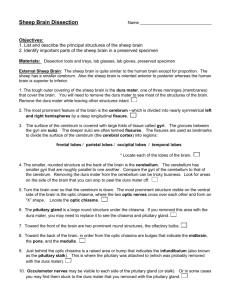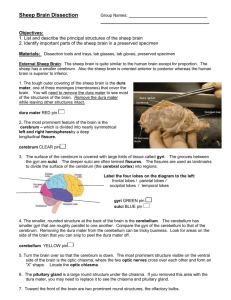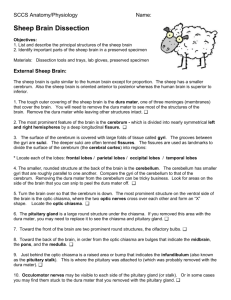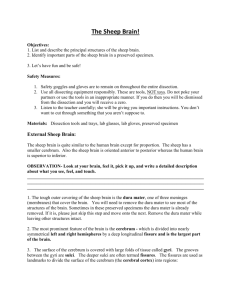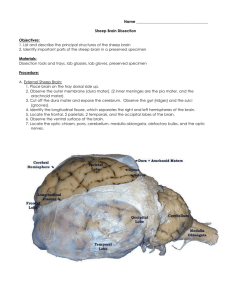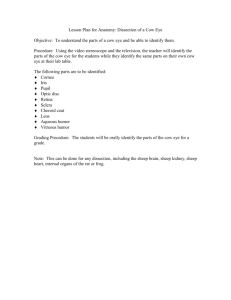LAB PRACTICE: check each box while you go through the brain
advertisement
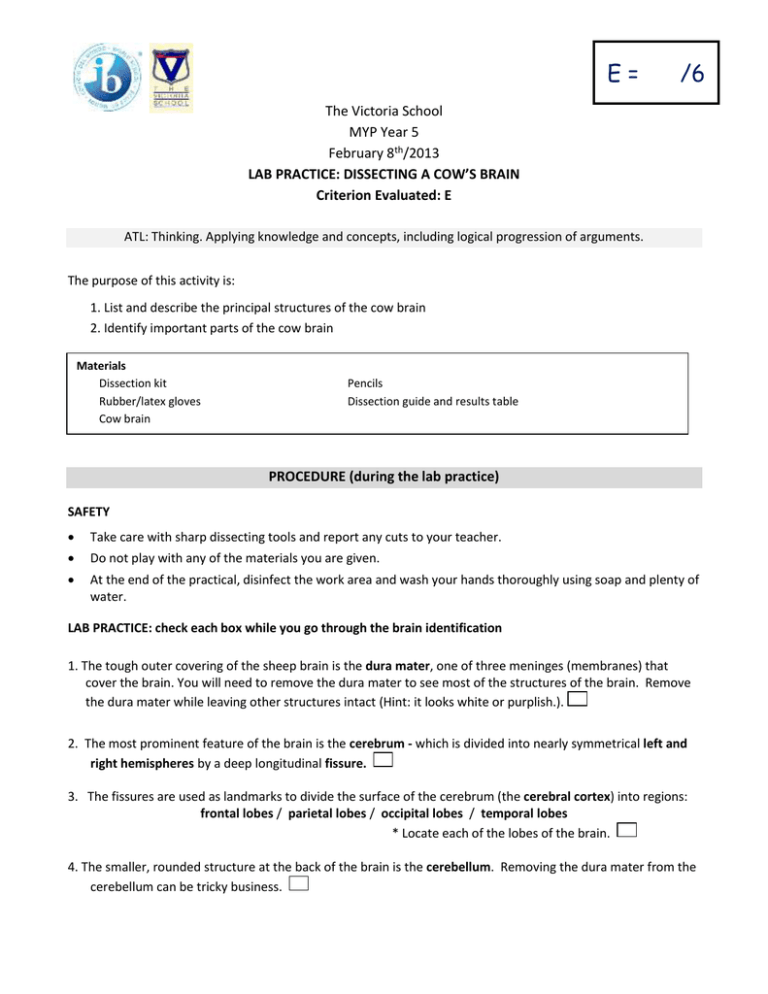
E= /6 The Victoria School MYP Year 5 February 8th/2013 LAB PRACTICE: DISSECTING A COW’S BRAIN Criterion Evaluated: E ATL: Thinking. Applying knowledge and concepts, including logical progression of arguments. The purpose of this activity is: 1. List and describe the principal structures of the cow brain 2. Identify important parts of the cow brain Materials Dissection kit Rubber/latex gloves Cow brain Pencils Dissection guide and results table PROCEDURE (during the lab practice) SAFETY Take care with sharp dissecting tools and report any cuts to your teacher. Do not play with any of the materials you are given. At the end of the practical, disinfect the work area and wash your hands thoroughly using soap and plenty of water. LAB PRACTICE: check each box while you go through the brain identification 1. The tough outer covering of the sheep brain is the dura mater, one of three meninges (membranes) that cover the brain. You will need to remove the dura mater to see most of the structures of the brain. Remove the dura mater while leaving other structures intact (Hint: it looks white or purplish.). 2. The most prominent feature of the brain is the cerebrum - which is divided into nearly symmetrical left and right hemispheres by a deep longitudinal fissure. 3. The fissures are used as landmarks to divide the surface of the cerebrum (the cerebral cortex) into regions: frontal lobes / parietal lobes / occipital lobes / temporal lobes * Locate each of the lobes of the brain. 4. The smaller, rounded structure at the back of the brain is the cerebellum. Removing the dura mater from the cerebellum can be tricky business. 5. Turn the brain over so that the cerebrum is down. The most prominent structure visible on the ventral side of the brain is the optic chiasma, where the two optic nerves cross over each other and form an “X” shape. Locate the optic chiasma. 6. The pituitary gland is a large round structure under the chiasma. If you removed this area with the dura mater, you may need to replace it to see the chiasma and pituitary gland. 7. Toward the front of the brain are two prominent round structures, the olfactory bulbs. 8. Toward the back of the brain, in order from the optic chiasma are bulges that indicate the midbrain, the pons, and the medulla. B. Internal Cow Brain. 1. Use a knife or long-bladed scalpel to cut the specimen along the longitudinal fissure. This will allow you to separate the brain into the left and the right hemisphere. Lay one side of the brain on your tray to locate the structures visible on the inside. You should also cut through the cerebellum. 2. The corpus callosum had been connecting the two cerebral hemispheres and can now be clearly seen in the brain section. 3. Inferior to the corpus callosum is a round structure known as the thalamus. It seems it almost perfectly centered. Just behind the thalamus is the pineal body (gland). The hypothalamus is also round shaped but is lower and toward the front of the brain. 4. Use a scalpel to cut a cross section of the cerebrum in the occipital lobe area. You should be able to see the color and texture differences of the white matter and the gray matter. Locate the following colored pins on the cut brain: Red: hypothalamus Yellow: medulla oblongata Green: white matter Blue: gray matter White: Cerebellum Black: Pituitary gland Observations 1. Write down 5 physical characteristics of your cow brain (for example: how the brain feels, color of the brain) a. b. c. d. e. Comparing Cow Brains to Human Brains 1. Label the brain parts in both the human and cow brain pictures. MEDIAL View of the Human Brain MEDIAL View of the Cow Brain 2. How are these brains similar? 3. Why might both brains be similar? 4. What is the function of the cerebellum? 5. What does the gray matter contains? How is its texture? 6. What does the white matter contains? How is its texture?
